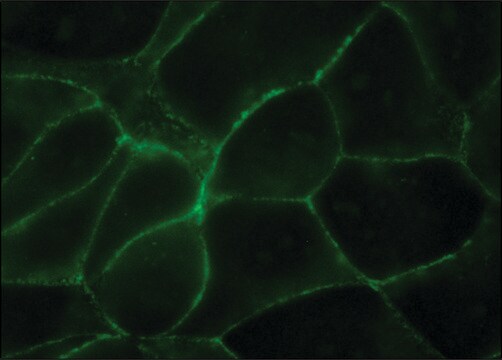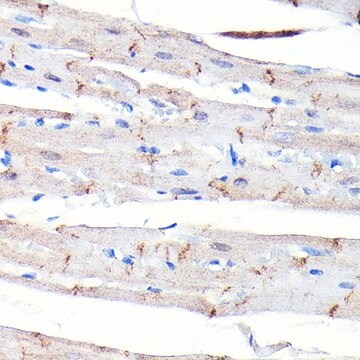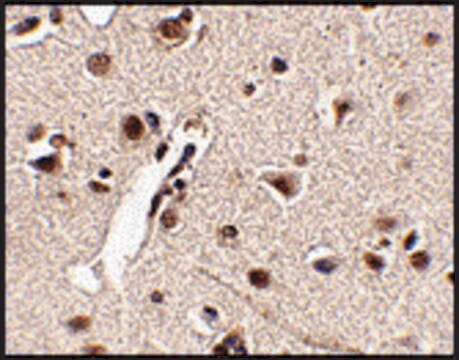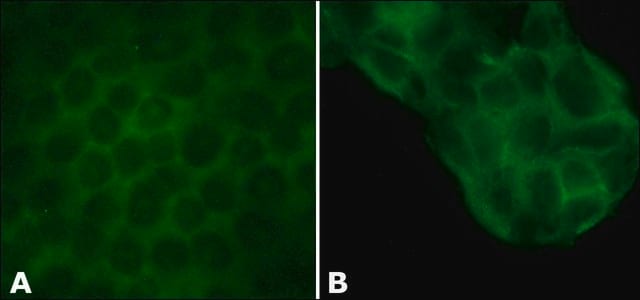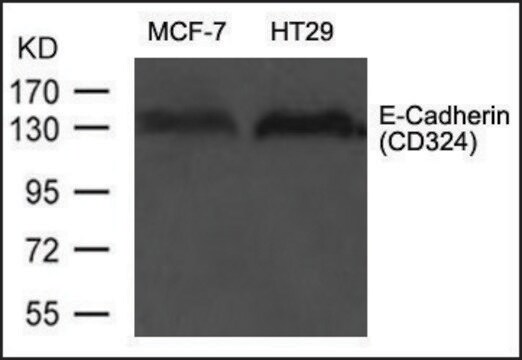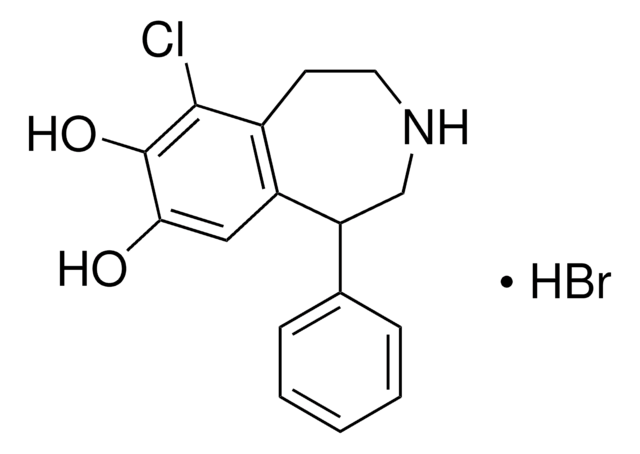추천 제품
생물학적 소스
rat
Quality Level
결합
unconjugated
항체 형태
ascites fluid
항체 생산 유형
primary antibodies
클론
DECMA-1, monoclonal
양식
buffered aqueous solution
포함
15 mM sodium azide
종 반응성
bovine, human, canine, mouse
기술
immunohistochemistry (frozen sections): suitable
immunoprecipitation (IP): suitable
indirect immunofluorescence: 1:1,600 using cultured MDCK cells
microarray: suitable
western blot: suitable
일반 설명
Monoclonal Anti-Uvomorulin/E-Cadherin (rat IgG1 isotype) is derived from the DECMA-1 hybridoma, produced by the fusion of rat myeloma cells and splenocytes from an immunized Lou rat. Uvomorulin protein was initially identified in embryonal carcinoma and is identical to E-Cadherin, liver-cell adhesion molecules (L-CAM), Cell CAM 80/120, and Activity-regulated cytoskeleton-associated protein 1 (ARC-1), each of which have been characterized in different systems. Uvomorulin/E-Cadherin has been characterized as a 120 kDa cell surface glycoprotein from which an 84 kDa fragment can be released by trypsin digestion in the presence of Ca2+.
특이성
Monoclonal Anti-Uvomorulin/E-Cadherin was selected against the mouse cell adhesion molecule uvomorulin/E-Cadherin. The antibody localizes the cell surface glycoprotein uvomorulin/E-cadherin that has been found to be identical to L-CAM, Cell CAM 80/120, and ARC-1. It blocks both the aggregation of mouse embryonal carcinoma cells and the compaction of pre-implantation embryos. The antibody disrupts confluent monolayers of Madin-Darby canine kidney (MDCK) epithelial cells. In indirect immunofluorescent staining of MDCK cells grown in culture, the antibody shows strong staining on the membrane of adjacent cells, after treatment with 0.5% Triton-X 100.
The antibody localizes the cell surface glycoprotein uvomorulin/E-cadherin that has been found to be identical to L-CAM, Cell CAM 80/120, and ARC-1. The antibody may be used for studies of embryonal development, cell-cell interactions of cultured cells, and localization of uvomorulin/E-cadherin in immunoblotting or immunohistochemical assays.
면역원
mouse embryonal carcinoma cell line PCC4 Aza R1.
애플리케이션
Monoclonal Anti-Uvomorulin/E-Cadherin has been used in immunofluorescence, immunoblotting, immunoprecipitation, immunohistochemistry, macromolecule permeability assay and agglomeration of two embryoid body assay.
면책조항
Unless otherwise stated in our catalog or other company documentation accompanying the product(s), our products are intended for research use only and are not to be used for any other purpose, which includes but is not limited to, unauthorized commercial uses, in vitro diagnostic uses, ex vivo or in vivo therapeutic uses or any type of consumption or application to humans or animals.
적합한 제품을 찾을 수 없으신가요?
당사의 제품 선택기 도구.을(를) 시도해 보세요.
Storage Class Code
12 - Non Combustible Liquids
WGK
nwg
Flash Point (°F)
Not applicable
Flash Point (°C)
Not applicable
가장 최신 버전 중 하나를 선택하세요:
시험 성적서(COA)
Lot/Batch Number
이미 열람한 고객
Jessica L Brusgard et al.
Oncotarget, 6(29), 28132-28150 (2015-09-01)
Intratumoral heterogeneity and treatment resistance drive breast cancer (BC) metastasis and recurrence. The RUNX2 transcription factor is upregulated in early stage luminal BC. However, the precise mechanism by which RUNX2 regulates an oncogenic phenotype in luminal BCs remains an enigma.
Reduced Pax2 gene dosage increases apoptosis and slows the progression of renal cystic disease
Ostrom L, et al.
Developmental Biology, 219(2), 250-258 (2000)
Controlled, scalable embryonic stem cell differentiation culture
Dang SM, et al.
Stem Cells, 22(3), 275-282 (2004)
Sylvain Bessonnard et al.
The Journal of cell biology, 210(7), 1185-1197 (2015-09-30)
The first cell differentiation in mammalian embryos segregates polarized trophectoderm cells from an apolar inner cell mass (ICM). This lineage decision is specified in compacted morulae by cell polarization and adhesion acting on the Yes-associated protein in the Hippo signaling
Maria P Gavilan et al.
PLoS biology, 13(3), e1002087-e1002087 (2015-03-13)
Epithelial morphogenesis involves a dramatic reorganisation of the microtubule cytoskeleton. How this complex process is controlled at the molecular level is still largely unknown. Here, we report that the centrosomal microtubule (MT)-binding protein CAP350 localises at adherens junctions in epithelial
자사의 과학자팀은 생명 과학, 재료 과학, 화학 합성, 크로마토그래피, 분석 및 기타 많은 영역을 포함한 모든 과학 분야에 경험이 있습니다..
고객지원팀으로 연락바랍니다.




